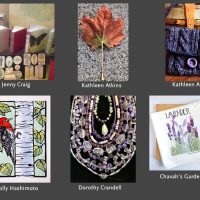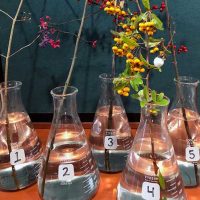December 2019 Plant Profile: Sequoia sempervirens

Having grown up in northern California, I came to the Seattle area with a treasured tree in my heart and could quickly answer the “favorite tree” question commonly asked in horticultural gatherings. Though my neighborhood was a bit inland and to the south of the coast redwood range (and so was surrounded by majestic oaks most of my days) it was the stunning Sequoia sempervirens forests along the northern coast where I hiked and camped which I considered iconically and perhaps spiritually my home.
Read moreHoliday Arts and Crafts Sale in the Miller Library

The annual Holiday Arts and Crafts sale in the Miller Library opens December 6th. This year we’ll have hand-knit items, kitchen wares with botanical flare, dramatic necklaces and more.
Read moreFall Fruits at the Washington Park Arboretum

1) Callicarpa sp. Beautyberry
The small, attractive metallic and purple berries give this ornamental shrub its common name.
The berries stay on the plant late into winter and are an important food source for wildlife.
This popular landscape plant provides a splash of color as fall sets in.
This and other Callicarpa can be seen from Arboretum Drive in our nursery.
Late Fall Interest in the Pacific Connections Garden

1) Cardiocrinum giganteum Giant Himalayan Lily
As its name suggests, this is a large lily that grows to be 8 to 10 feet tall with huge fragrant white flowers followed by attractive seed pods that progress from green to brown and contain hundreds of thin-layered seeds.
The remaining stalks with seed pods can be found in the Pacific Connections China Garden.
November 2019 Plant Profile: Ilex verticillata ‘Nana’ RED SPRITE
Ilex verticillata ‘Nana’, typically sold as ‘Red Sprite’ or under the trade name RED SPRITE, is a dwarf winterberry cultivar that is an outstanding choice for late fall and winter landscapes, especially for those with limited space. The bright red berries are produced in abundance and are its outstanding ornamental feature. Unlike most winterberries, which can reach to 5-8’ high and wide or more, ‘Red Sprite’ is only 2’ to 3’ tall and wide at maturity.
Read moreAll About the Genus Picea

1) Picea orientalis Oriental Spruce
This popular ornamental spruce can grow up to 150 feet and is native to the Caucasus Mountains and northern Asia Minor.
This species is prized for its gracefully pendulous foliage and for the young cones which are deep purple.
A grove of these trees can be found on the northeast side of the Pinetum.
2) Picea morrisonicola Taiwan Spruce
Endemic to the mountains of Taiwan, this spruce has slender, delicate shoots.
Read more13th Annual Rare Plant Monitoring Weekend

Each year the Rare Plant Care and Conservation Program (Rare Care) hosts a weekend to monitor rare and threatened plants of Washington State. Trained monitoring volunteers, Rare Care staff, and National Forest staff work together to collect data on rare plant populations. This year’s monitoring weekend was held in the Colville National Forest. Based at Frater Lake, we camped below the stars and woke to the chattering of red squirrels busy with their daily chores.
Read moreRare Care’s Botanical Explorations

This spring, the Rare Plant Care and Conservation program (Rare Care) launched a new initiative in partnership with the Washington Natural Heritage Program to conduct botanical surveys of several Department of Natural Resources (DNR) Natural Area Preserves (NAP) and Natural Resource Conservation Areas (NRCA). Our goal is to expand our understanding of the botanical diversity of these preserves and the flora of Washington State.
Read moreOctober 2019 Plant Profile: Osmanthus x fortunei ‘San Jose’

Osmanthus x fortunei, commonly known as sweet olive, was first introduced to Holland in 1856 by German botanist, Philipp Franz von Siebold; it is named after Scottish plant hunter, Robert Fortune, who introduced it to England in 1862. It is a hybrid between Osmanthus fragrans and Osmanthus heterophyllus, and is Japanese in origin. The cultivar ‘San Jose’ was introduced in 1941 by W.B.
Read moreReflections from Rare Care Intern Callie Zender

Over the summer, my fellow intern, Maya Kahn-Abrams, and I monitored twelve species of alpine plants in Olympic and Mount Rainier National Parks. These plants were chosen from a list developed by botanists from each park to describe current status and collect long-term data to develop strategies for adaption to climate change. These species are generally tracked by the Washington Natural Heritage Program, while a majority of them are endemic to Washington State.
Read more